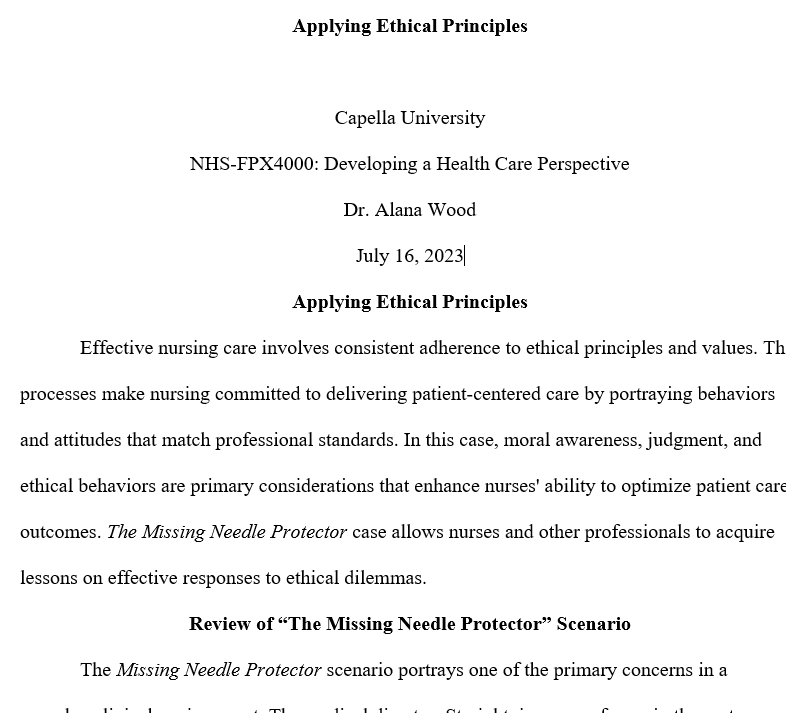Capella University
NHS-FPX4000: Developing a Health Care Perspective
Dr. Alana Wood
July 16, 2023
Applying Ethical Principles
Effective nursing care involves consistent adherence to ethical principles and values. The processes make nursing committed to delivering patient-centered care by portraying behaviors and attitudes that match professional standards. In this case, moral awareness, judgment, and ethical behaviors are primary considerations that enhance nurses’ ability to optimize patient care outcomes. The Missing Needle Protector case allows nurses and other professionals to acquire lessons on effective responses to ethical dilemmas.
Review of “The Missing Needle Protector” Scenario
The Missing Needle Protector scenario portrays one of the primary concerns in a complex clinical environment. The medical director, Straight, is aware of gaps in the system and the need to introduce meaningful changes. However, multiple barriers including power imbalances and unethical habits undermined the desire for change. For instance, Dr. Cutrite uses power politics to continue serving as a physician despite having mental and physical health issues. In this case, it is appropriate for the doctor to reconsider participating in medical procedures, including sensitive ones such as surgeries. The inability to maintain a responsible and accountable workforce explains the resulting ethical dilemma, where the surgical team left a needle in the patient’s belly. Findings revealed inadequate risk assessment, such that the team failed to notice that a red-pink-colored protector was difficult to detect once soaked in blood. The scenario increases the risk of exposing a patient to physical, emotional, and psychological distress. The case reminds healthcare professionals to be vigilant in sensitive scenarios.
Ethical Issues
The scenario reveals violations of ethical principles associated with moral awareness, moral judgment, and ethical behavior. Negligence and non-compliance with calls for patient-centered and outcome-based care raise questions about the care team’s commitment to improving the quality and safety of care (Bakhtiari et al., 2020). For instance, the scrub nurse acted negligently by failing to identify and report a visible risk. Another concern is the failure to adopt a comprehensive risk assessment framework, which would allow the care team to understand the implications of using a red-pink protector. The invisible nature of the equipment once soaked in blood was enough for the team to consider using an alternative that would help protect the patient from harm. Additionally, the operating room supervisor responded inappropriately to the situation by failing to prevent Cutrite from being part of a delicate procedure. Inefficiencies and unresponsiveness to issues during and after the surgery raise questions about the care team’s compliance with the principles of moral awareness, moral judgment, and ethical behavior.
Ethical Decision-Making Model Associated with the Scenario
The events provide insights into the need for healthcare professionals to comply with the principles of moral awareness, ethical behavior, and moral judgment. Firstly, moral awareness is a primary consideration that makes members of the care team aware of the consequences of their actions. Familiarizing with the consequences of ineffective practice makes individuals committed to identifying and intercepting risks before initiating an operation (Bakhtiari et al., 2020). Secondly, moral judgment guides healthcare professionals to differentiate between right and wrong choices. Sound judgment reminds care professionals about the need to uphold the right actions and attitude when handling complex situations (Milliken, 2018). With ethical behavior, healthcare professionals respond to patients’ interests by eliminating risks and meeting clients’ interests. For instance, it was wrong for Cutrite to be involved in a surgery despite struggling with mental and physical challenges. The medical director and the operating room supervisor had the opportunity to demonstrate moral awareness and judgment by opposing Cutrite’s decision to be part of the operation.
Communication Approaches to Address Ethical Dilemma
Effective communication involves proactive discussions and reporting of issues within the clinical environment. Healthcare leaders should have the knowledge and skills to initiate objective discussions on the right care plan to improve the quality and safety of patient care (Alnaser, 2020). The operating room supervisor engaged the medical director to describe events that led to the team leaving a surgical instrument in the patient’s belly. The conversation revealed intent listening and minimal interruptions that would allow the two to understand the situation and respond appropriately. Further, the supervisor provided a detailed explanation of the events, which made it easier to make an objective conclusion on the best intervention. Thus, honesty and transparency are crucial considerations that make the care team responsive to ethical dilemmas (Alnaser, 2020). However, the decision to conceal critical information undermines efforts to address an ethical dilemma. The outcome is a failure to identify the root cause of a problem and evidence-based solutions meant to protect the patient from physical, psychological, and emotional harm.
Addressing the Ethical Dilemma
The ethical dilemma reveals serious challenges in the surgical department. Future patients may be vulnerable to fatalities due to the incapacity of physicians such as Cutrite and the scrub nurse to address risks in the surgical setting. The medical director responded well to the scenario by discussing the events with the operating room supervisor. The process enables Straight to acquire accurate and complete evidence on human, technical, and administrative gaps that led to the instrument being left on the patient’s belly. From the conversation with the operating room supervisor, Straight asked objective questions about the incident and the implications of leaving the plastic needle protector in Jameson’s belly. Additionally, more discussions with the surgical team also provided insights into the events that transpired and the right course of action. Thus, addressing an ethical dilemma require healthcare leaders to remain objective and transparent when seeking information. The director understood the principles of beneficence and non-maleficence, including considering removing the tool and safeguarding the patient from future harm. The dilemma reinforces the need for healthcare professionals to adequately identify challenges and make informed decisions on interventions required to prevent similar scenarios.
Conclusion
Successful care outcomes depend on efforts to deliver patient-centered care characterized by an accurate and complete analysis of risks and their consequences. The Missing Needle Protector captures the need for healthcare professionals to demonstrate moral awareness, moral judgment, and ethical behavior. Commitment to upholding ethical principles enables the care team to address human, technical, and administrative gaps before handling complex procedures such as surgery. Further, the case reveals the importance of accountability and responsibility to ensure that everyone has the right mental, emotional, and physical capacity to be part of a surgical team.
References
Alnaser, F. A. (2020). Effective communication skills and patient’s health. CPQ Neurology and Psychology, 3(4), 1-10. https://www.cientperiodique.com/article/CPQNP-3-4-55.pdf
Bakhtiari, S., Rakhshan, M., Shahriari, M., & Sharif, F. (2020). Perspective and experience of operating room personnel on ethical behaviors. Electronic Journal of General Medicine, 17(3), 1-9. https://www.ejgm.co.uk/download/perspective-and-experience-of-operating-room-personnel-on-ethical-behaviors-7821.pdf
Capella University. (n.d). Ethical Case Studies: The missing needle protector. Capella University. https://media.capella.edu/CourseMedia/nhs4000element18655/wrapper.asp
Milliken, A. (2018). Ethical awareness: What it is and why it matters. The Online Journal of Issues in Nursing, 23(1), 1-7. https://doi.org/10.3912/OJIN.Vol23No01Man01

